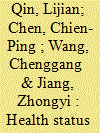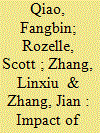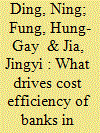| Srl | Item |
| 1 |
ID:
138104


|
|
|
|
|
| Summary/Abstract |
This paper uses a panel data-fixed effect approach and data collected from Chinese public manufacturing firms between 1999 and 2011 to investigate the impacts of business life cycle stages on capital structure. We find that cash flow patterns capture more information on business life cycle stages than firm age and have a stronger impact on capital structure decision-making. We also find that the adjustment speed of capital structure varies significantly across life cycle stages and that non-sequential transitions over life cycle stages play an important role in the determination of capital structure. Our study indicates that it is important for policy-makers to ensure that products and financial markets are well-balanced.
|
|
|
|
|
|
|
|
|
|
|
|
|
|
|
|
| 2 |
ID:
138107


|
|
|
|
|
| Summary/Abstract |
The migration of rural laborers into cities for employment has been one of the main driving forces of China's economic growth over the past three decades. Based on a dataset collected by the Ministry of Agriculture of China from 2003 to 2007, this paper examines the impact of health on the earnings of migrant workers engaging in physically-intensive work requiring good health. Our findings indicate that a poor health status not only weakens the incentive of rural laborers to participate in the migrant labor force but also significantly reduces their earnings. A migrant worker in poor health only earns 67 percent of what a healthy worker makes. Among all the human capital characteristics and family economic factors, health status is the most influential on earnings for less educated workers. Labor productivity has a greater impact on earnings than the annual number of days that a person works. Ongoing health-care reforms aimed at the improvement of the health-care services available to rural laborers are urged to help reduce poverty in rural China.
|
|
|
|
|
|
|
|
|
|
|
|
|
|
|
|
| 3 |
ID:
138108


|
|
|
|
|
| Summary/Abstract |
Using individual data collected in rural China and adopting Heckman's two-step function, we examined the impact of childcare and eldercare on laborers' off-farm activities. Our study finds that having school-aged children has a negative impact on rural laborers' migration decisions and a positive impact on their decision to work in the local off-farm employment market. As grandparents can help to take care of young children, the impact of preschoolers is insignificant. Having elderly family to care for decreases the income earned by female members of the family. Although both men and women are actively engaged in off-farm employment today in rural China, this study shows that women are still the primary care providers for both children and the elderly. Therefore, reforming public school enrollment and high school/college entrance examination systems so that migrant children can stay with their parents, this will help rural laborers to migrate to cities. The present study also calls for more public services for preschoolers and the elderly in rural China.
|
|
|
|
|
|
|
|
|
|
|
|
|
|
|
|
| 4 |
ID:
138103


|
|
|
|
|
| Summary/Abstract |
The present paper studies the sources of economic growth and the nature of structural change in the Chinese economy from 1987 to 2008. Using a methodology that evaluates the contribution of an industry to economic growth, the present paper shows that the post-2000 subperiod marked an increased reliance on the services sector as a source of growth in the Chinese economy. Much of the acceleration in real GDP or aggregate labor productivity growth in China in the post-2000 subperiod compared to the pre-2000 period can be traced to an increased contribution from service-producing and high-technology exporting manufacturing industries. The evidence indicates that the Chinese economy has been rebalancing toward domestic consumption and shifting its export sector toward high-technology manufacturing industries.
|
|
|
|
|
|
|
|
|
|
|
|
|
|
|
|
| 5 |
ID:
138105


|
|
|
|
|
| Summary/Abstract |
This paper examines the spatial externality from foreign direct investment on domestic firms. Using Chinese firm-level data for 2004, and after accounting for an endogeneity problem, we find that foreign firms generate a significantly positive spillover effect on the regional productivity of domestic firms in similar counties and industries. Estimating a spatial-autoregressive model, we further show that such local spillovers could transmit to domestic firms in other counties and industries through interactions among domestic firms. However, these spatial multiplier effects decline with distance, thereby reducing the foreign direct investment spillover effects for domestic firms in distant locations.
|
|
|
|
|
|
|
|
|
|
|
|
|
|
|
|
| 6 |
ID:
138106


|
|
|
|
|
| Summary/Abstract |
This study uses stochastic frontier analysis to examine the factors that influenced cost efficiency of banks in China from 2005 to 2013. The results indicate that policy variables, such as the reserve requirement ratio, the interest rate spread and open market operations by the People's Bank of China, are effective in improving the cost efficiency of banks, but shadow banking variables may reduce cost efficiency. Among the various bank types, city commercial banks appear to be the most efficient and foreign banks are the least efficient. The present study suggests that policy-makers can have a positive influence on bank cost efficiency by adjusting macro policy variables on different types of banks and by requiring more information on the shadow banking activities to improve monitoring.
|
|
|
|
|
|
|
|
|
|
|
|
|
|
|
|